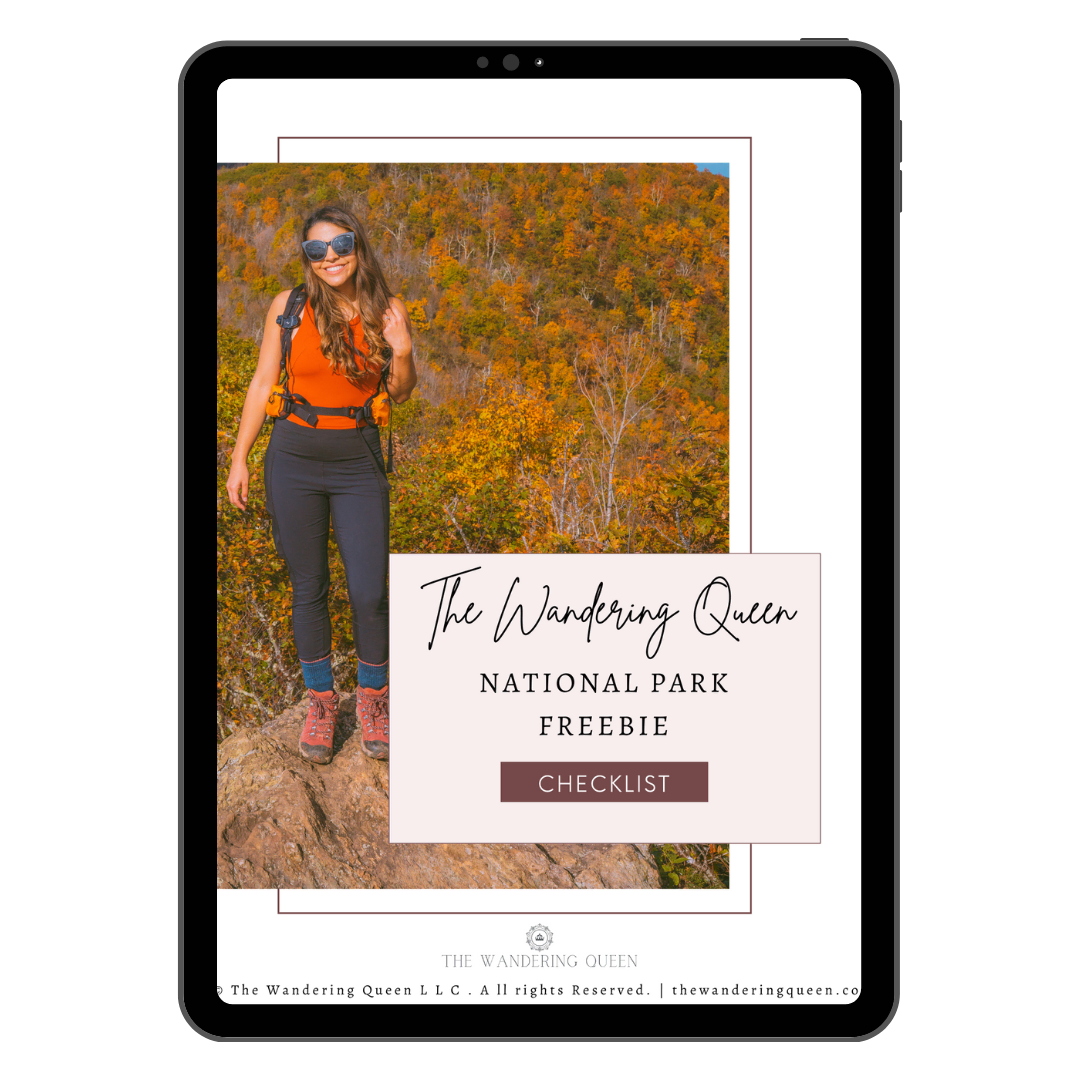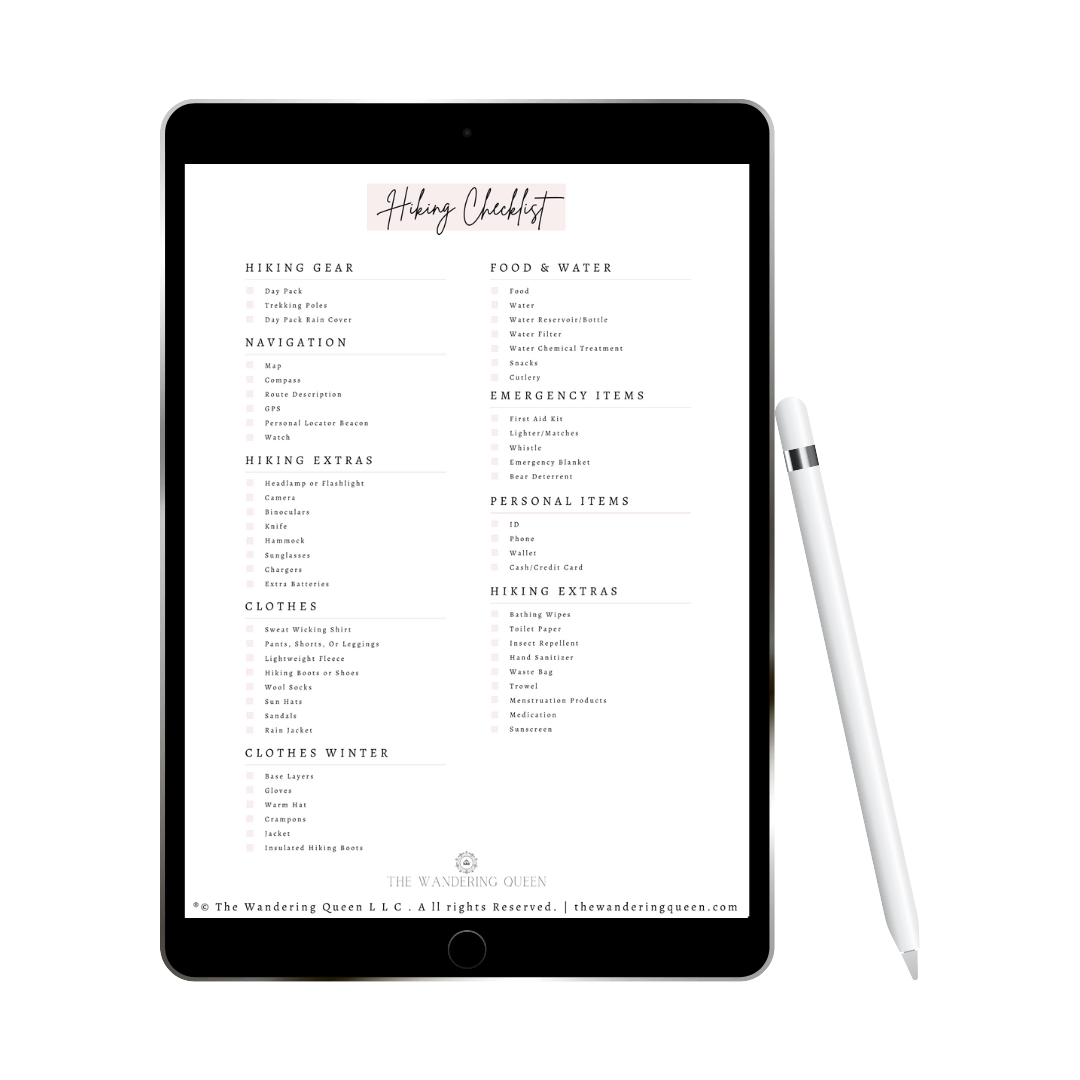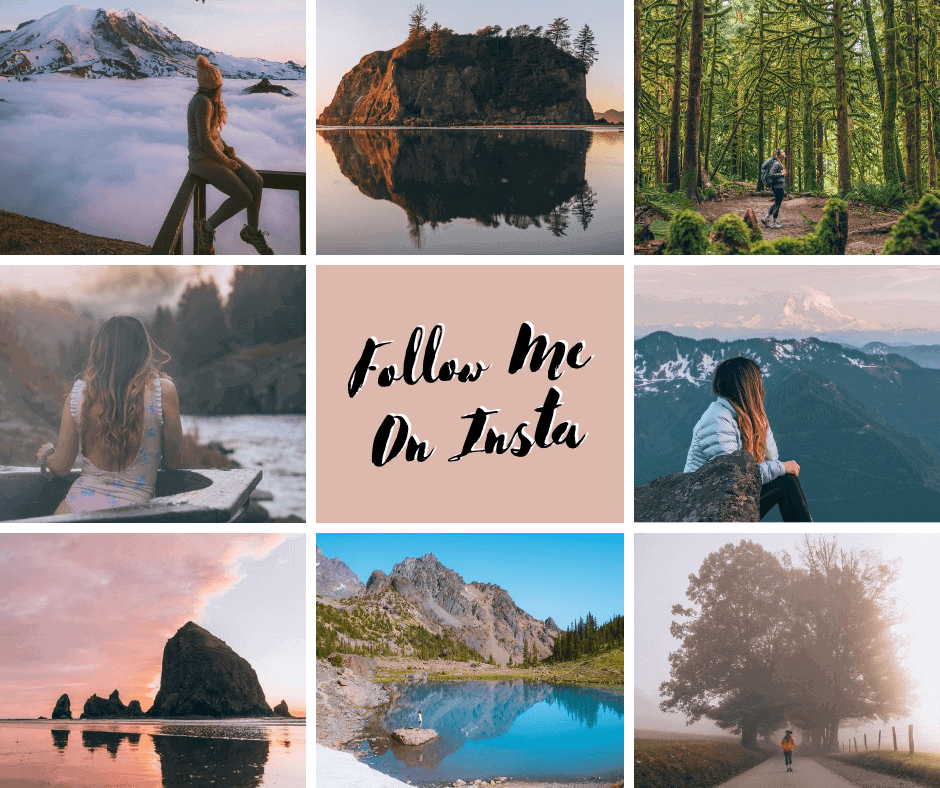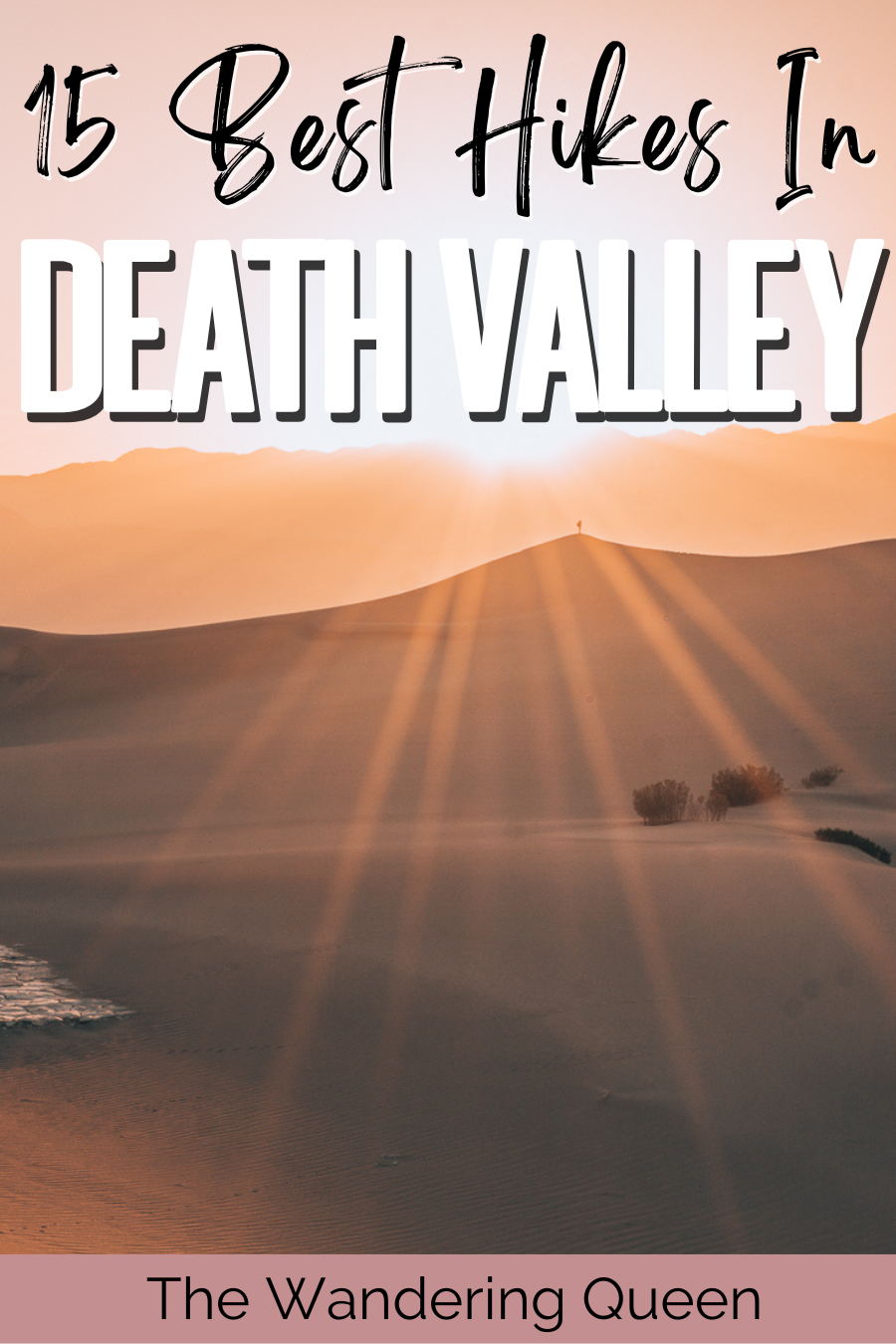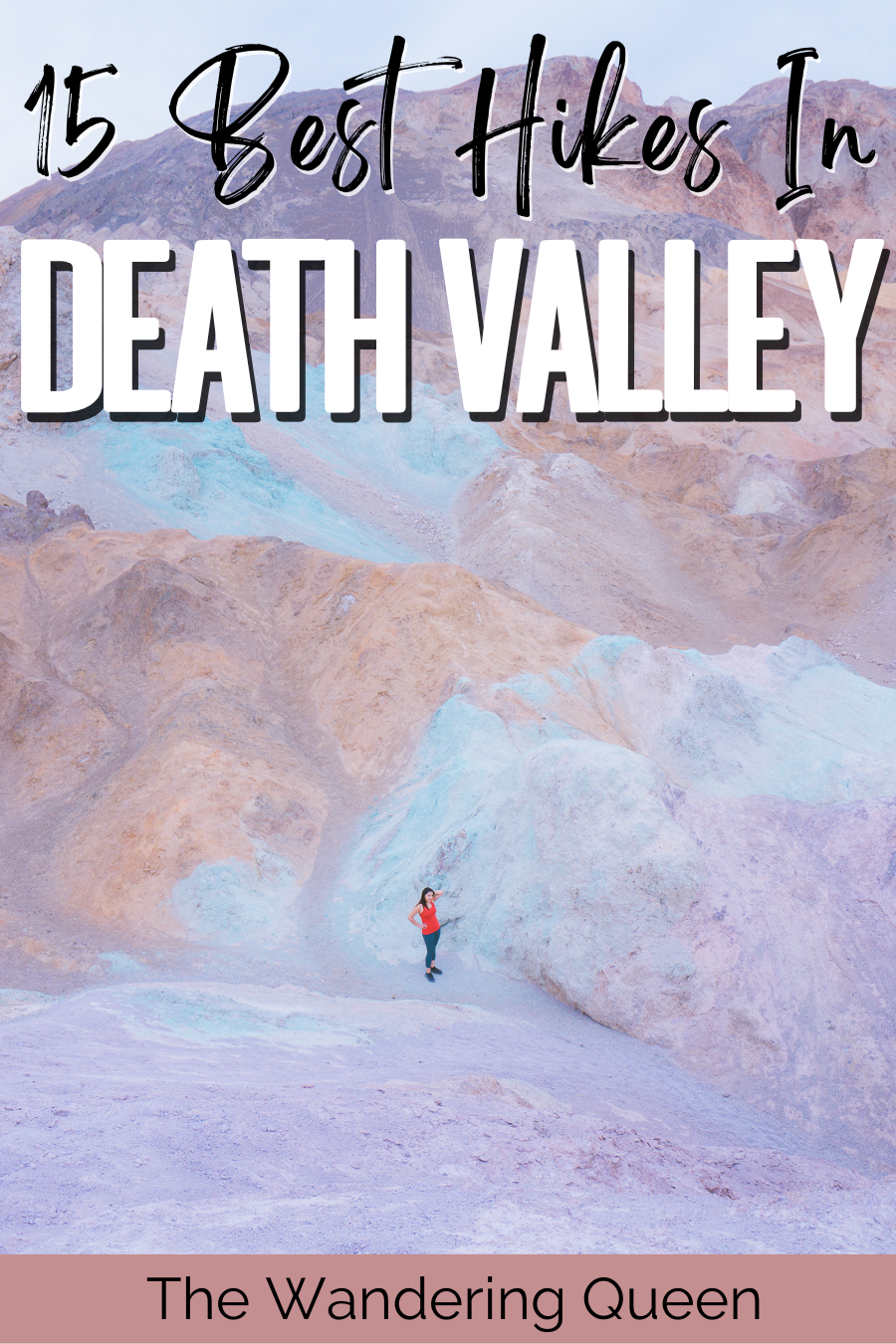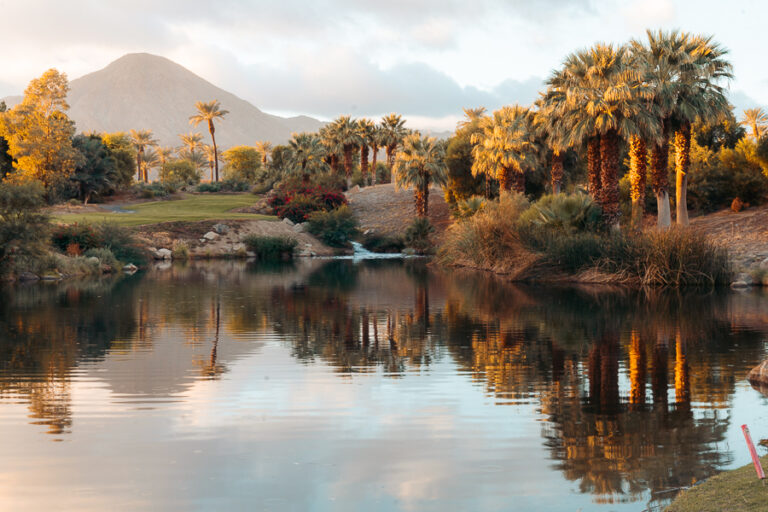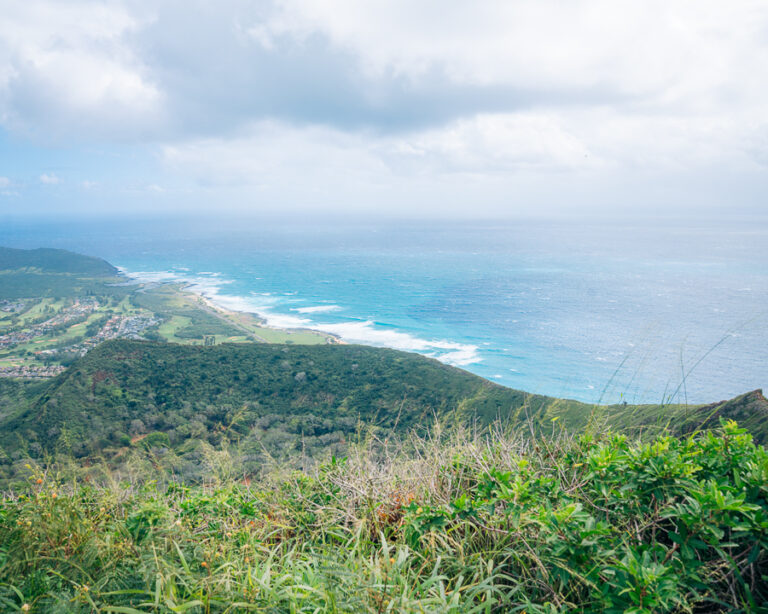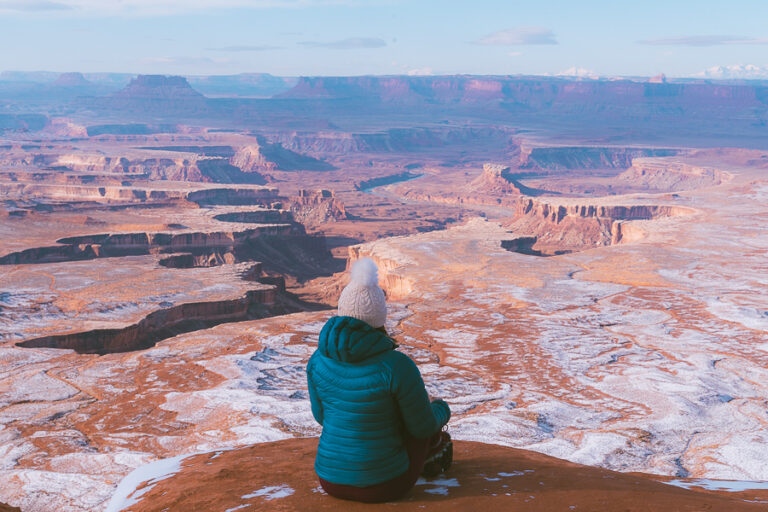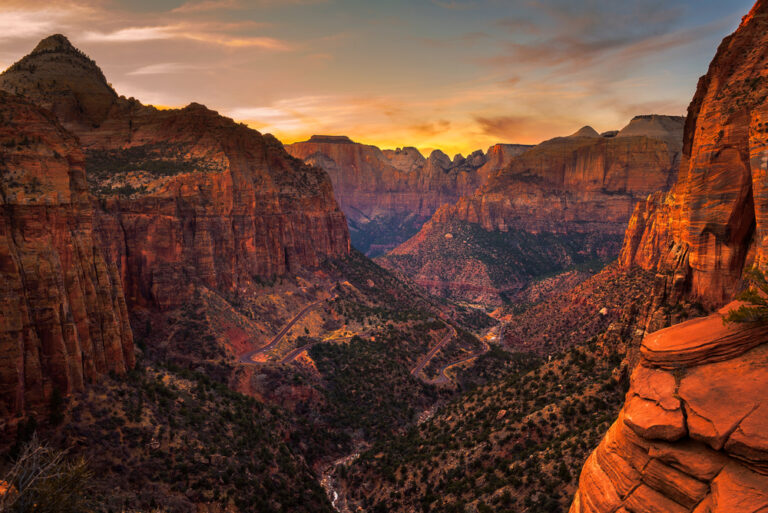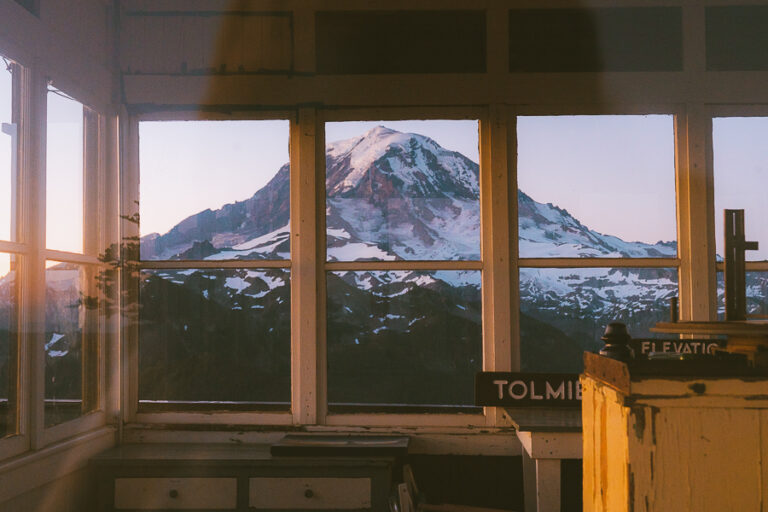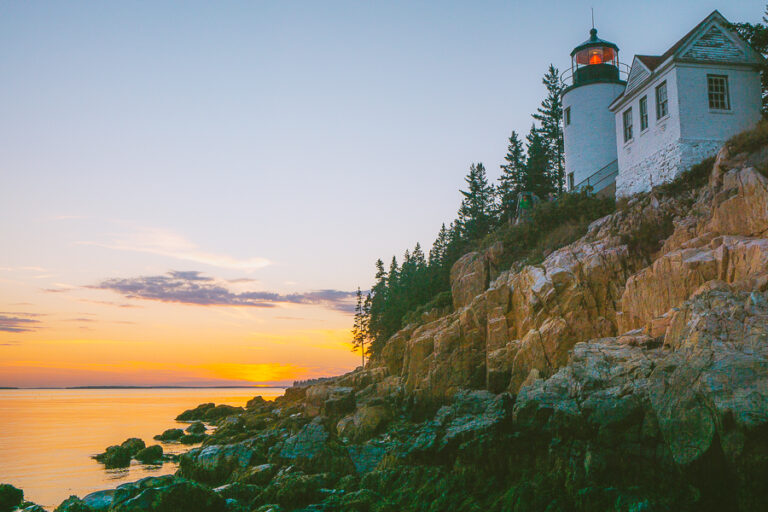Best Hikes in Death Valley National Park: 15 Unique Hiking Trails
If you’re looking for a hike that will take your breath away, literally and figuratively, then you’re sure to find the ideal trail in Death Valley. Or, if you’re seeking something casual with incredible views, then this US park has you covered, too.
Death Valley is home to many hiking trails ranging from easy to strenuous, so there’s something for everyone. So what are you waiting for? Lace up your hiking boots, pack in your sunscreen, grab your water bottle and get ready to tackle some of the best hikes in Death Valley.
Wondering what else this beautiful destination has to offer? Check out this guide on the best Death Valley things to do.
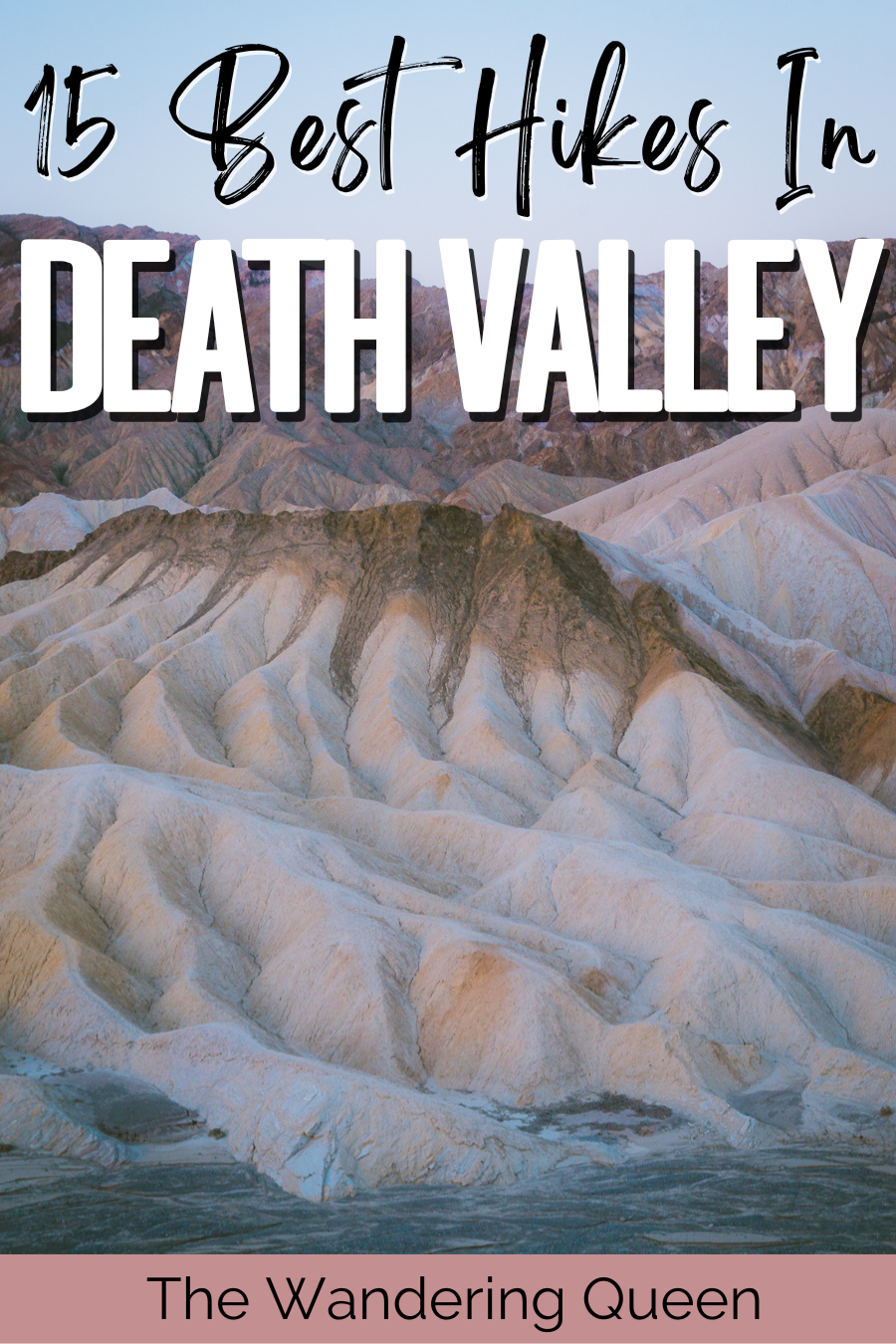
Disclosure: This post contains affiliate links. If you click one of them, I may receive a small commission (for which I am very grateful for) at no extra cost to you.
Death Valley National Park
Related Posts
Tours Of Death Valley
What To Pack For Hiking Death Valley
- Sunscreen: This is a no brainer. There are areas on the trail where there is no shade. Slather some on right before the trek. >Buy Sunscreen
- Hiking Boots/Shoes: If you use tennis shoes you can easily hurt your toes hitting a rock by accident (Trust me I have done it so many times before). >Check Out My Hiking Shoes
- Hiking socks: Having the correct socks helps you prevent getting blisters. Smart Wool is probably my favorite brand out there. >Buy Hiking Socks
- Refillable water bottle: I always bring a Hydroflask on all my adventures. They are on the heavier side, but I know for a fact they will not break. I have had a few cheap water bottles break on me before. There is no room for error at Death Valley. >Check Prices Now
- Lots of water: Death Valley is HOT. Bring a ton of water!
- Sunglasses: Like I said, it can get pretty sunny.>Check Out These Sunglasses
- Snacks: The best snacks are jerky, nuts, energy bars. Cliff Bars are great for hiking.
- Trekking Poles: This is an optional product, but they really help with the knees. The poles I have listed are known to be one of the best in the market. >Buy The Trekking Poles Here
- Camera: I have linked the camera I used to take pictures of the Grand Canyon. The Sony A6000 is a great camera for people that want to start improving at travel photography. >Buy Sony Camera Here
- First Aid Kit: This is one of the first things I bought when I first started backpacking and camping. It is super portable. >Buy This Awesome First Aid Kit Here
- Day Pack: The REI bag I have linked, we have had for seven years now, and it is still going strong! >Buy This Great Quality Backpack
- Good hiking pants: These are probably the best hiking pants that I have found. They keep you dry in the crazy weather, and they are durable. >Buy my hiking pants here
- Breathable sweat-wicking shirts: >Check This One Out
- Sports Bra: For women. >Buy One Here
- Jacket: Only in the winter >Buy My Favorite Jacket
- National Park Pass: I highly recommend getting a year-long America The Beautiful Pass. >Get It Here
- Map: I love the National Geographic Maps! They are the best! >Buy One Here
Claim your FREE Hiking Checklist
Ready to start hiking? Grab my free hiking checklist and never forget anything at home!
Where to Stay When Hiking in Death Valley
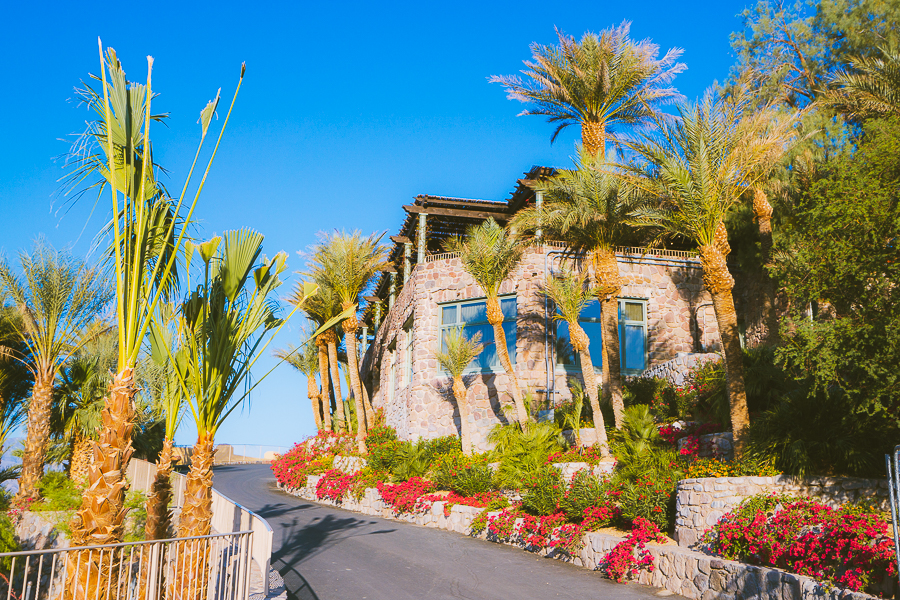
Since you are going to need several days in the park to experience all that it has to offer, you will need comfortable accommodation to rest, too. Here are some of the best places to stay when visiting Death Valley.
Luxury: The Inn at Death Valley
The Inn at Death Valley is an AAA-rated four-diamond resort that once served as an exclusive desert escape for many of Hollywood’s elites. Today, it aims to bring the elegance of Old Hollywood to each of its valued guests by providing the most luxurious experiences.
At the resort, you will find a variety of stylishly-appointed rooms. These come equipped with modern amenities, including a flat-screen TV, a private bathroom, and plenty more.
There are also plenty of facilities for you to enjoy. This includes a spring-fed swimming pool, a beautiful garden, a state-of-the-art gym, and a relaxing spa. There’s also a restaurant serving some of the best American cuisines. And when you’re not out exploring Death Valley, enjoy activities such as tennis and golf, too. >>>Check Availability
Mid-range: Panamint Springs Motel & Tents
Panamint Springs is a small, western-style resort located in Death Valley’s Panamint area. For those seeking affordable accommodation near many of the national park’s top attractions, this is a great pick.
Panamint Springs offers a variety of accommodation types. This includes 14 historic motel rooms, 9 new cabin-style motel rooms, a cottage, and several tent cabins. There are also several RV sites and campsites on the premises for those looking to rough it out.
Regarding amenities, Panamint Springs has you covered, too. You’ll find a lovely restaurant and bar that serves some of the best Angus Beef Burgers and American-made craft beer. There’s also a gas station and general store here, so you can pick up whatever you may need for your hiking trips. >>>Check Availability
Budget: Camp in Death Valley
One of the best and most budget-friendly ways to experience Death Valley is by camping. There are many campgrounds found throughout the national park—each with its own unique charms.
Some of the most popular developed campgrounds include Furnace Creek, Emigrant, Texas Springs, Sunset, Wildrose, Stovepipe Wells, and Mesquite Spring. These are generally open on a first-come-first-serve basis, so you will need to travel here to find an empty spot.
There are also several private-owned campgrounds, as well as primitive campgrounds. >>>Find out more
Read More: Where to Stay in Death Valley | 13 Hotels, Resorts & Camping Spots
Map Of Best Hikes In Death Valley National Park
15 Best Death Valley Hikes
If you’re seeking a thrilling outdoor adventure, Death Valley is a great place to explore. Here are some of the best hiking trails located throughout the national park.
Zabriskie Point
- Elevation Gain: 50 feet
- Mileage: 0.4 miles (out and back)
- Difficulty: Easy
- Trail Guide: Link
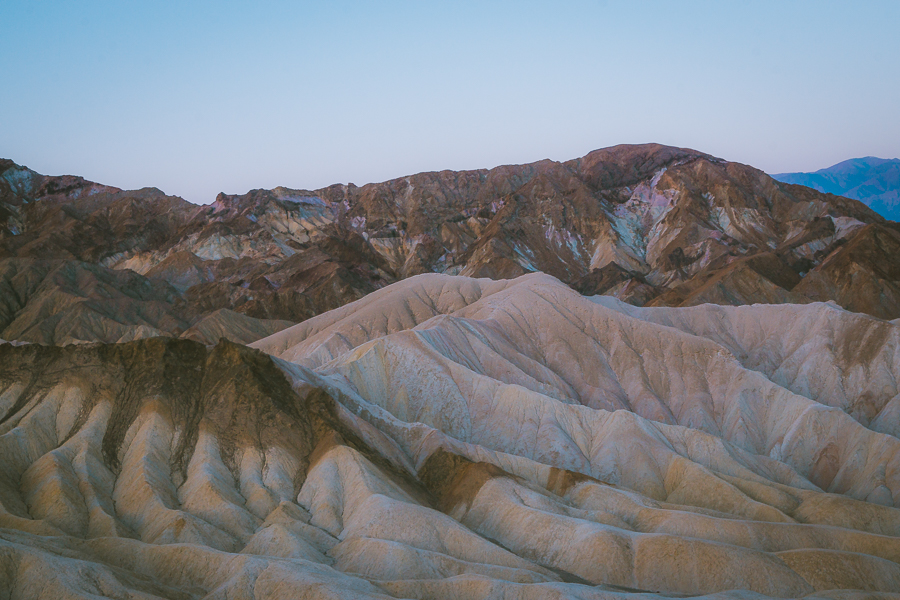
Zabriskie Point is, without a doubt, one of the most scenic viewpoints in Death Valley National Park. And best of all, it is easily accessible via a short path, making it a suitable pick for most visitors.
Most people flock to the iconic Zabriskie Point during sunrise to catch a glimpse of the beautiful badlands as it takes on a violet, pink, and golden hue with the crack of dawn.
The natural phenomenon is especially popular amongst photographers who visit to capture award-winning images of Death Valley. If this sounds like you, then be sure to bring along your camera gear.
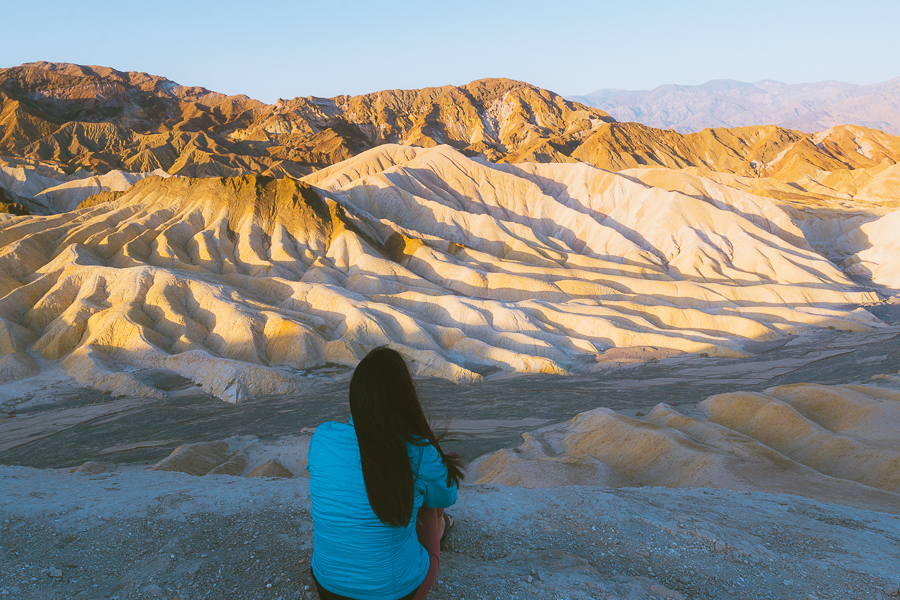
While sunrise is certainly the most popular time of day to visit, sunset offers some incredible views, too. If you’re looking to avoid the larger crowds, arrive as early as possible or visit later in the day.
Regardless of when you visit, you’ll still be able to enjoy breathtaking views of the dramatically eroded terrain and various sights. This includes Manly Beacon, Red Cathedral, and the giant elephant toes.
Badlands Loop
- Elevation Gain: 535 feet
- Mileage: 2.7 miles (loop)
- Difficulty: Moderate
- Trail Guide: Link
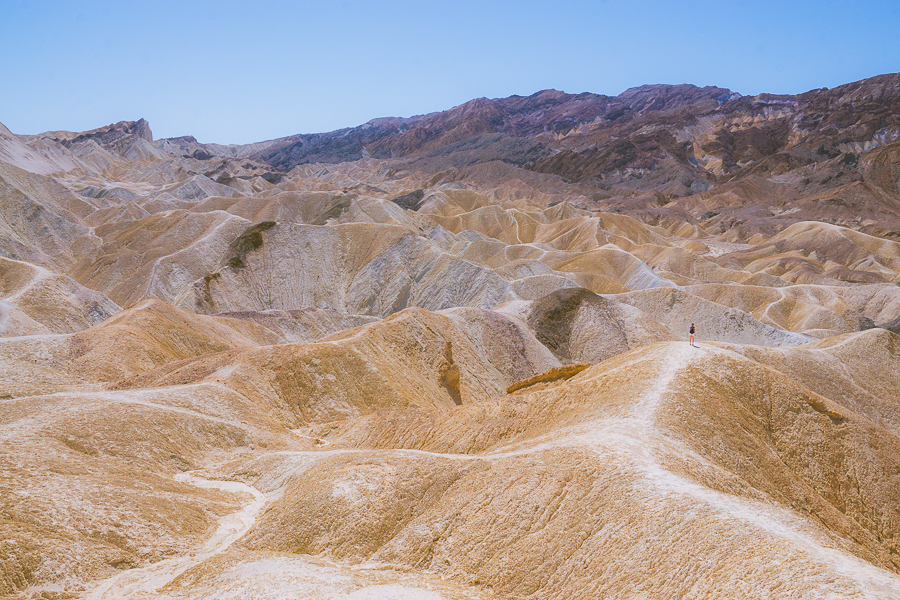
From Zabriskie Point, you can continue down onto the 2.7-mile Badlands Loop. This will provide you with a unique opportunity to explore the ridges of the badlands and see the beautiful streaks of color up close.
The trail involves a gradual descent down through an expanding gully. Shortly in, you’ll find yourself in one of the major arteries of Gower Gulch. At this point, you can choose to turn left towards Gower Gulch or right, which will lead you out of the wash.
Many opt for the easier route to the right as it takes you up the dried mudstone walls before opening up to more views of the badlands and various other Death Valley attractions, including Manly Beacon and Red Cathedral.

Tip: Follow the loop after sunrise as the soft morning light compliments the slopes’ unique colors and textures.
Golden Canyon – Gower Gulch Loop
- Elevation Gain: 1,082 feet
- Mileage: 6.4 miles (loop)
- Difficulty: Moderate
- Trail Guide: Link
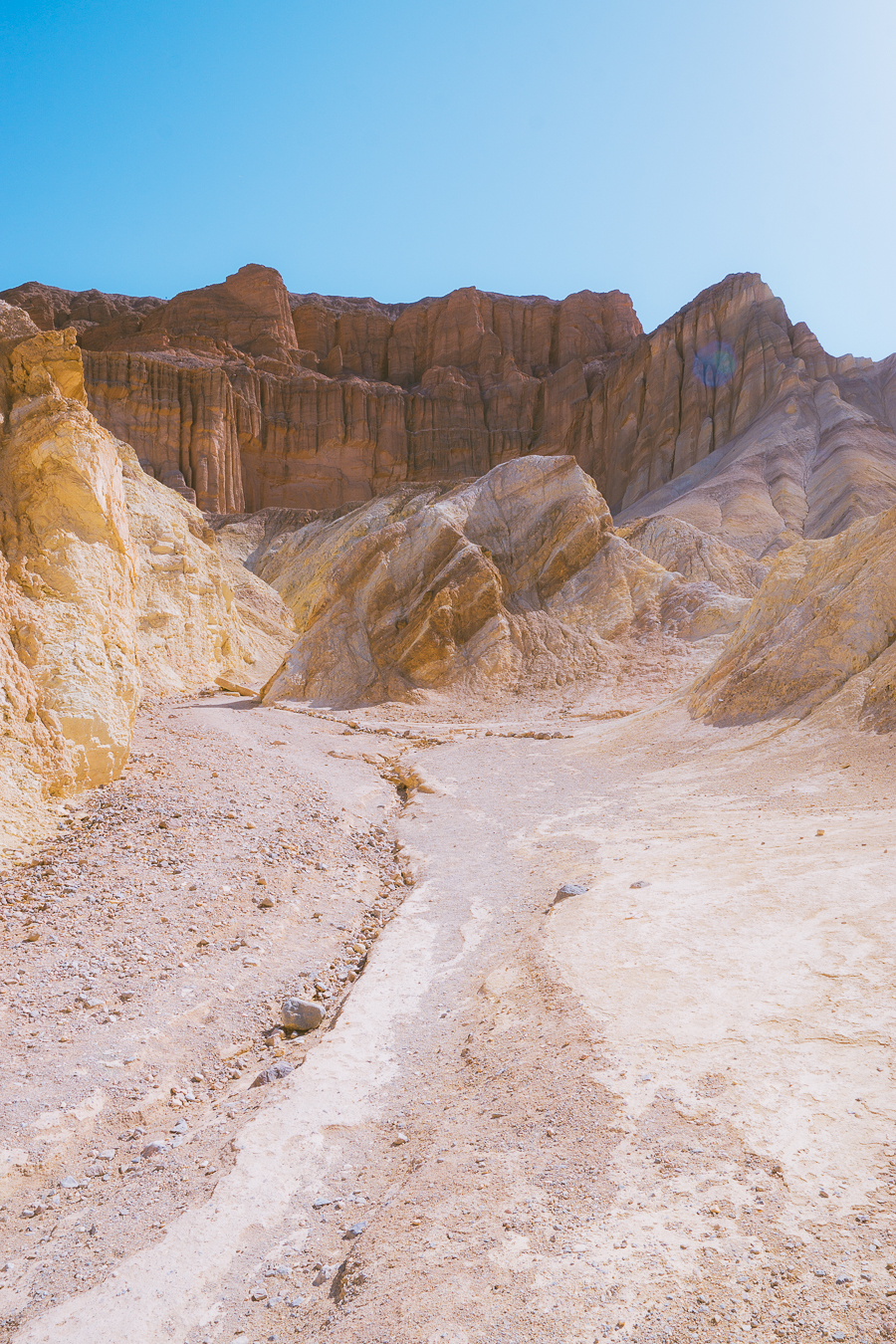
Golden Canyon is one of the most popular attractions in Death Valley National Park. In fact, it is the location for several Star Wars scenes. In addition to this, it is renowned for being one of the park’s most beautiful trails.
While you can do the Golden Canyon Trail on its own as an out-and-back, doing it with the Gower Gulch Trail as a loop is recommended. This route comprises an uphill, rocky climb and requires some scrambling.
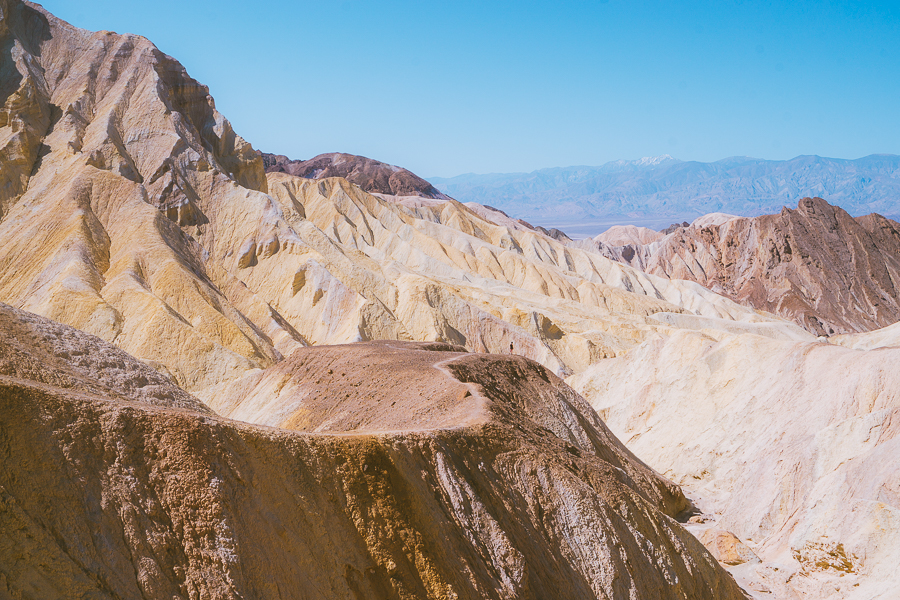
This will take you through colorful rock faces toward the famous Red Cathedral. You’ll also pass by Manly Beacon before reaching the red rock formation.
Following this, you’ll have two options. You can make your way back to the parking lot and complete the loop or continue your descent down into Gower Gulch. This can be challenging as there is no firm trail heading down. However, the views are stunning, and you’ll have an easy way out of the wash once you’ve reached the bottom.

Tip: Come early, as this Death Valley trail gets crowded quickly.
Telescope Peak Hike
- Elevation Gain: 3,323 feet
- Mileage: 12.7 miles (loop)
- Difficulty: Hard
- Trail Guide: Link
If you’re seeking something more challenging, then this is the trail for you. Telescope Peak sits 11,049 feet above sea level and is the tallest point in Death Valley National Park. As you can expect, reaching the summit is quite challenging. However, the views from the top make it more than worthwhile.
Begin the hike at the trailhead near Mahogany Flat Campground and begin your climb up the eastern slope of the Panamint Mountains. This portion of the trail is pleasant as it is lined with Pinyon pine trees. Then, the vegetation slowly clears, providing you with clear views over the valley.
Following this, the trail travels below Rogers Peak, overlooking Hanaupah Canyon. It then levels out at Arcane Meadows, where you’ll have views of both Panamint and Death Valley. This location is a popular camping spot for backpackers. If this is you, make sure you’ve got all your backpacking essentials.
The remainder of the trail follows a narrow ridgeline, occasionally passing by limber and ancient bristlecone pines. This portion experiences a significant 1000-ft gain before reaching the summit of Telescope Peak.
Download my free Outdoor Photography Guide
Artist’s Palette Hike
- Elevation Gain: 108 feet
- Mileage: 0.3 miles (out-and-back)
- Difficulty: Easy
- Trail Guide: Link
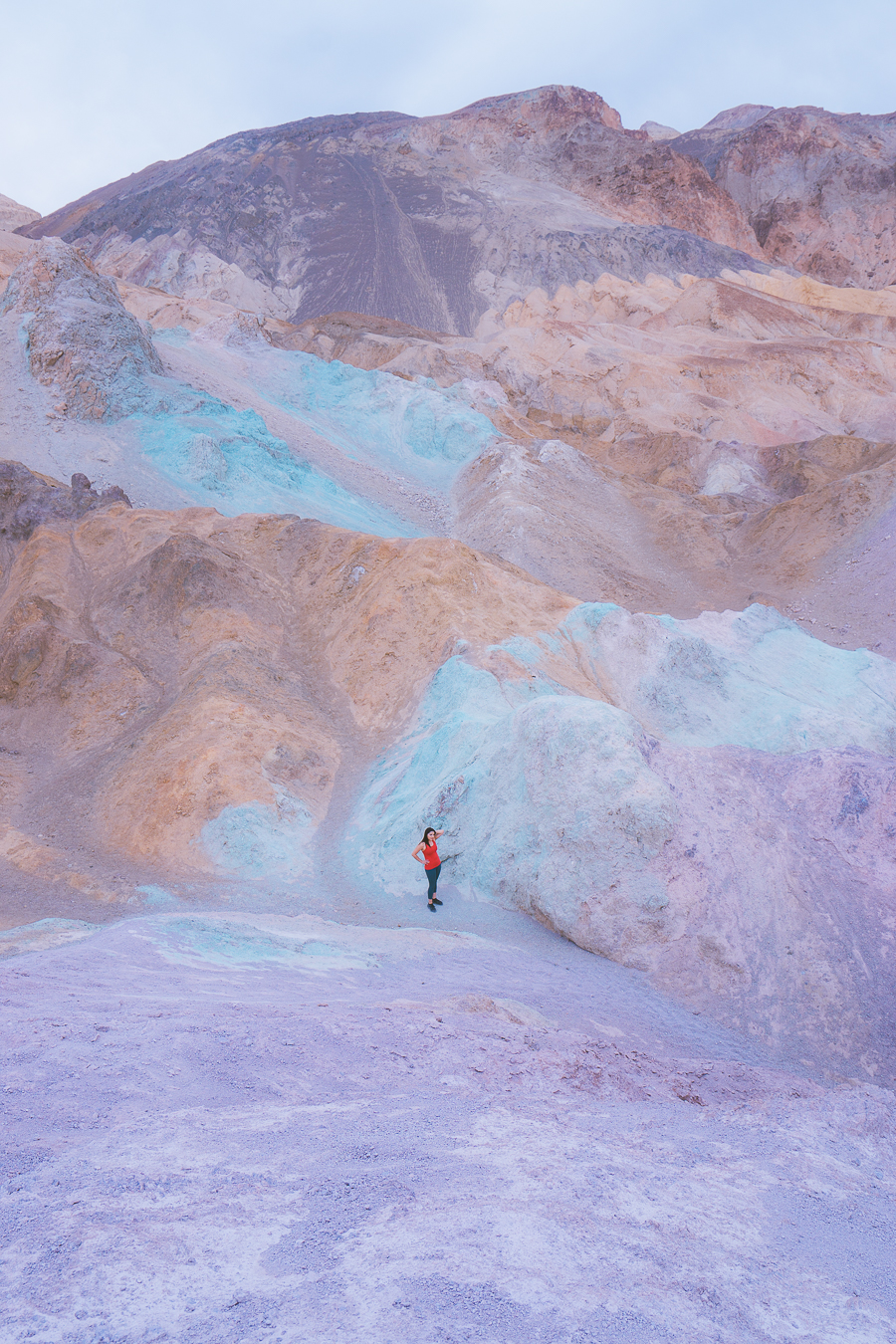
Artist’s Drive and Artist’s Palette are two of the most popular sights in Death Valley. The natural wonder is a result of magma-heated water, lava, and ash. The result is a colorful mineral deposit comprising everything from lavender, blues, and greens to pinks, reds, and browns.
To access this attraction, take a scenic drive up toward the Artist’s Palette Viewpoint. You can choose to view Painted Hills from here or descend down into the wash for a close-up look. There is no designated trail down, so you’re free to explore the wash to your heart’s content.
To see each of the colors come to life, it is best to visit during sunrise or sunset. The sunlight really changes the look of the landscape, making it the perfect subject matter for your Death Valley photos and Instagram feed.
Read More: Best Hikes in Pinnacles National Park: 10 Thrilling Hiking Trails
Grotto Canyon
- Elevation Gain: 672 feet
- Mileage: 2.1 miles (out-and-back)
- Difficulty: Hard
- Trail Guide: Link
The next entry on this list is a lesser-known trail. This is largely due to the trail being a bit too challenging for most. The trail involves everything from climbing to scrambling—and everything in between.
The trailhead is located near the Mesquite Flat Sand Dunes and Stovepipe Wells and can be accessed via an unmarked gravel road. Shortly after starting the hike, the trail canyon begins to narrow before introducing two challenging obstacles.
The first is a 15-ft climb up a rocky surface, which may require rope and a harness. The second is another climb with smaller rocks to help you grip. Later on, you’ll stumble upon another obstacle that will prove to be more challenging than the ones encountered at the beginning of the trail. This is a strenuous climb up an 8-ft chimney that requires good upper body strength and climbing experience.
Lastly, you will have to bypass a high pour-over, as well as a high wall of chockstones wedged between water-polished walls. Following this, many hikers choose to turn back if they have not done so already. From here, you’ll be met by a new series of challenges as you make your way back down toward the trailhead.

Tip: As this trail involves a lot of climbing, ensure that you have the appropriate hiking gear.
Badwater Basin Salt Flats Trail
- Elevation Gain: 7 feet
- Mileage: 1-5 miles (out-and-back)
- Difficulty: Easy
- Trail Guide: Link
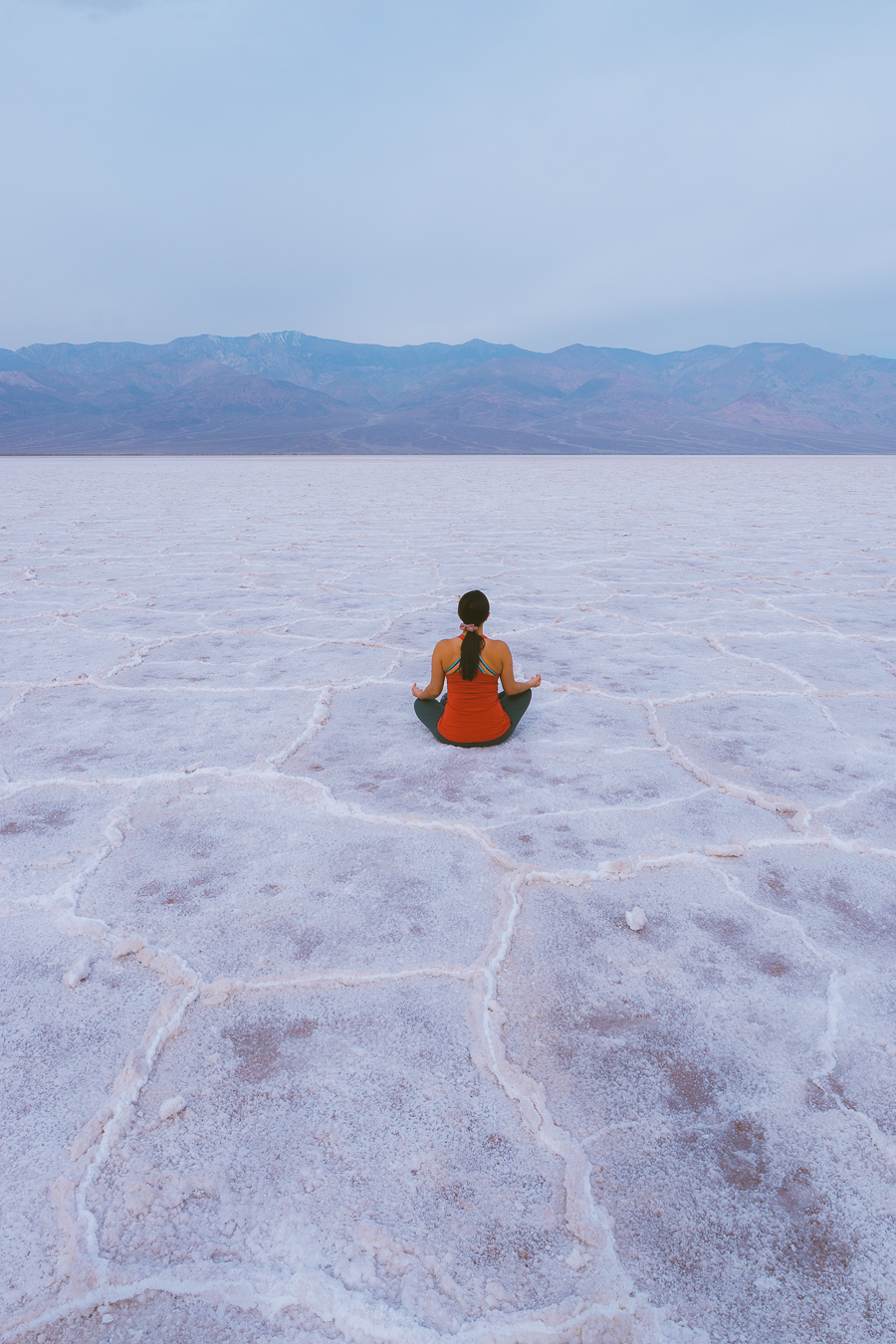
Another must-visit attraction in Death Valley National Park is Badwater Basin. This is the lowest point in North America, sitting at 282 feet below sea level.
The basin is filled with Sodium Chloride—better known as table salt. Don’t believe me? Then be sure to taste the salt yourself.
The hike to this natural wonder is easy, comprising a mostly flat walk along a boardwalk. This will take you to the edge of the salt bed. From this point, you can step onto the hexagon-shaped salt crystals and begin exploring.
The walk from one side of the basin to the other is around 5 miles, though you can choose how far you wish to go. Just be mindful of the borders, as stepping on these will cause them to collapse. While you wander around, be sure to snap pictures of the seemingly never-ending crystal salts and the tall mountains in the background.

Tip: Do not visit Badwater Basin during the heat of the day as the trail offers no shade.
Mosaic Canyon Trail
- Elevation Gain: 958 feet
- Mileage: 3.3 miles (out-and-back)
- Difficulty: Moderate
- Trail Guide: Link
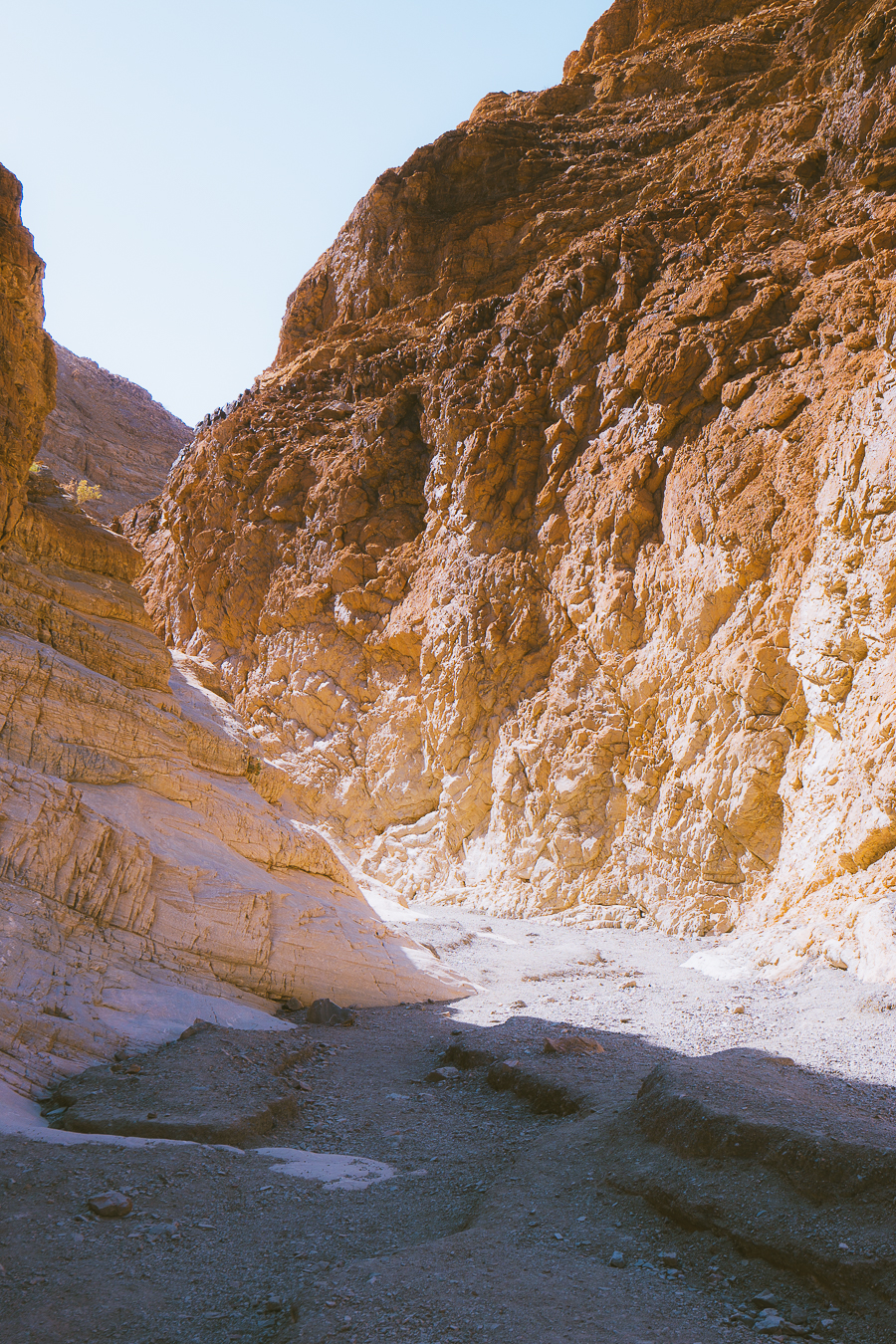
If you’re into interesting rock formations, then be sure to tackle the Mosaic Canyon hiking trail. Here the canyon walls are lined with thick slabs of marble, which is completely cool to the touch. As such, it is one of the best summer hiking destinations as the temperature remains cool thanks to the canyon walls.
Many will find that this is one of the most rewarding and enjoyable hikes in Death Valley National Park. To start, head to the trailhead near Mosaic Canyon Road. From here, you will follow an easy, flat trail toward the first set of narrows.
Following the first stretch, you will need to do a fair bit of climbing and scrambling before reaching a beautiful amphitheater with a dry fall at the end. Many visitors opt not to do this portion as it is far more challenging.
Regardless, the hike is still worthwhile, as seeing the smooth, natural mosaic at the beginning trail remains a must.

Tip: Wear a good pair of hiking shoes as the rocks tend to be slippery.
Natural Bridge Canyon
- Elevation Gain: 450 feet
- Mileage: 1.4 miles (out-and-back)
- Difficulty: Easy
- Trail Guide: Link
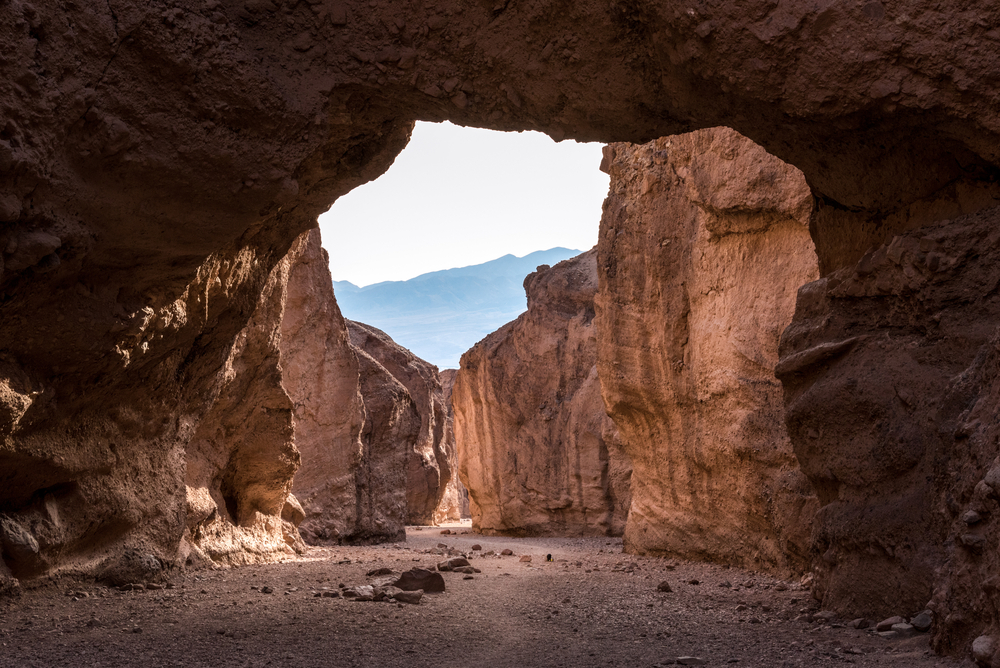
The trail to Natural Bridge is one of the easier routes found within Death Valley National Park. It takes you to a stunning natural bridge that was left behind following the erosive effects of water on the canyon walls.
To start the hike, head to the trailhead located along Natural Bridge Road. From the parking lot, follow the relatively easy trail down into the mouth of the canyon. The route experiences little elevation; however, it is rock and can be narrow and uneven at times. As such, you should be sure to watch your step.
Not far in, you will stumble across the famous natural bridge, which extends across the breadth of the canyon. Spend some time admiring the beautiful rock formation before heading back to the parking lot. For those seeking more adventure, you can also travel further as there is a dry fall not too far from the bridge.
Salt Creek Interpretive Trail
- Elevation Gain: 0 feet
- Mileage: 0.5 miles (out-and-back)
- Difficulty: Easy
- Trail Guide: Link
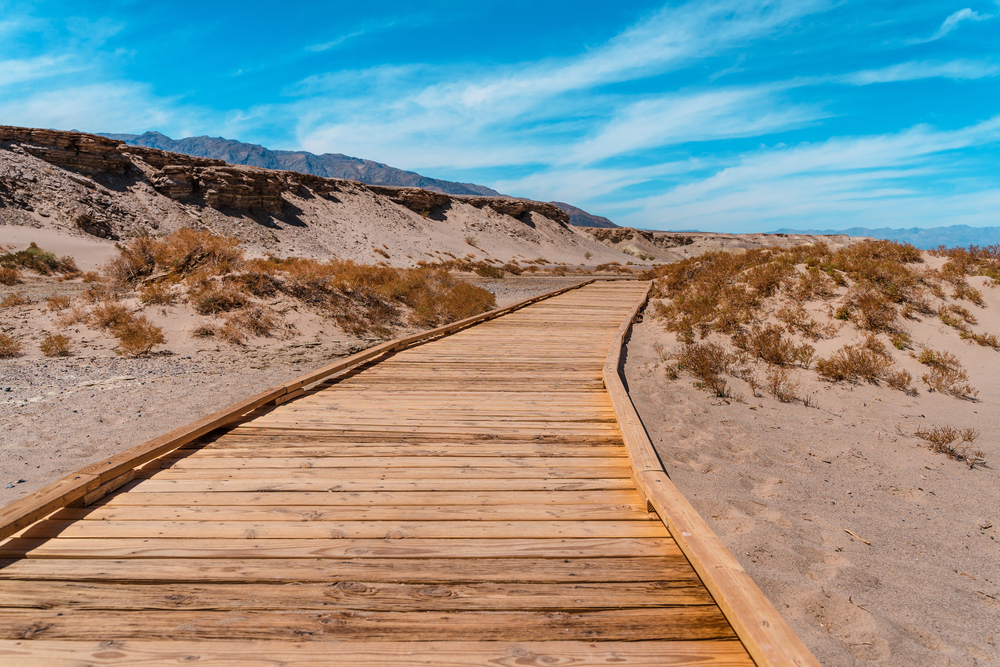
The Salt Creek Interpretive Trail is another easy hike that’s perfect for the entire family. It involves an easily accessible wooden boardwalk, which is open year-round. However, it is best to visit between November and May as you’ll find pools of water within the creeks.
From the well-maintained boardwalk, look into the pools to try and spot the Death Valley pupfish. This is a small endangered species of fish endemic to only two sections of the park. If you’re visiting with kids, they’re sure to love this.
This trail is also popular amongst birders as it is where you’ll see the largest variety of bird species in all of Death Valley. Bring your binoculars and try to spot the northern flicker, belted kingfisher, and various other birdlife. There’s also a wide variety of reptiles, including the long-nosed leopard lizard and desert iguana.
Grab Your Free Car Camping Checklist! 🚗🌲
Ready to elevate your car camping game? Snag our essential checklist to ensure you’ve got everything you need for a stress-free, fun-filled adventure! Perfect for beginners and seasoned campers alike. Download now and hit the road prepared! 🌟🎒
Mesquite Flat Sand Dunes Hike
- Elevation Gain: 206 feet
- Mileage: 2.8 miles (out-and-back)
- Difficulty: Easy/moderate
- Trail Guide: Link
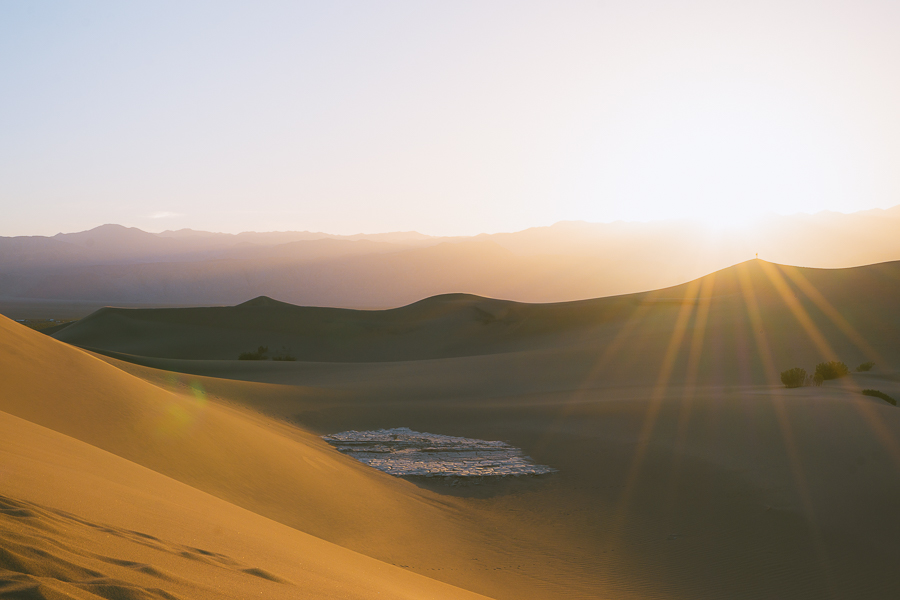
The Mesquite Flat Sand Dunes hike is one of the most popular Death Valley trails. This is because it is fun for both adults and kids.
There is no formal trail, so you can wander around as you see fit. However, if you wish to climb the tallest dune, you will need to walk around 2 miles there and back.
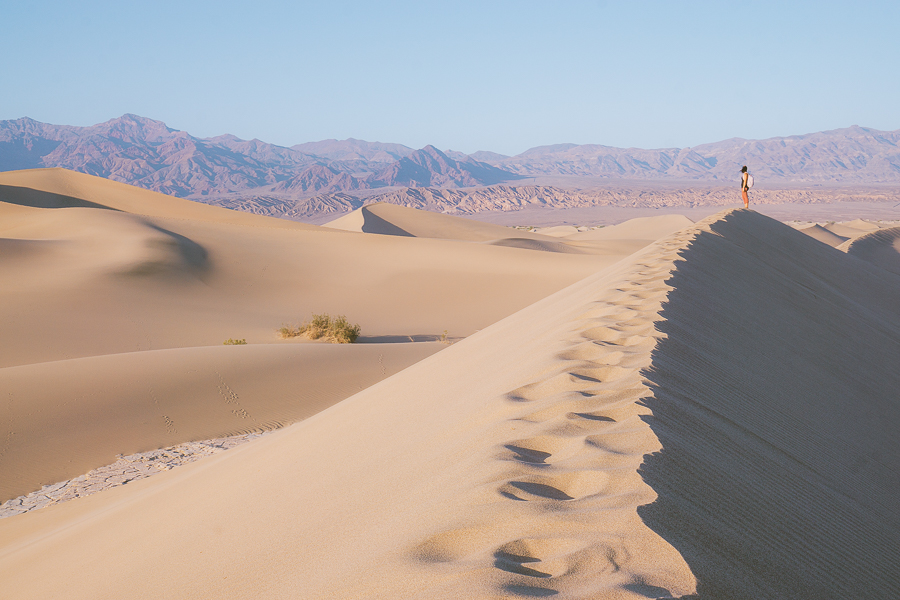
The best time of day to visit the sand dunes is during sunrise or sunset. This is because the temperatures are cooler, and the sunlight brings out the vibrant color of the soft, loose sand.
The Mesquite Flat Sand Dunes is also a popular spot amongst photographers as the vast desert landscape makes for some incredible shots. As it is easily accessible, you’ll likely see weddings, engagements, or other photoshoots taking place here.

Tip: Bring plenty of water, especially if you’re visiting during midday.
Darwin Falls Trail
- Elevation Gain: 450 feet
- Mileage: 2 miles (out-and-back)
- Difficulty: Moderate
- Trail Guide: Link
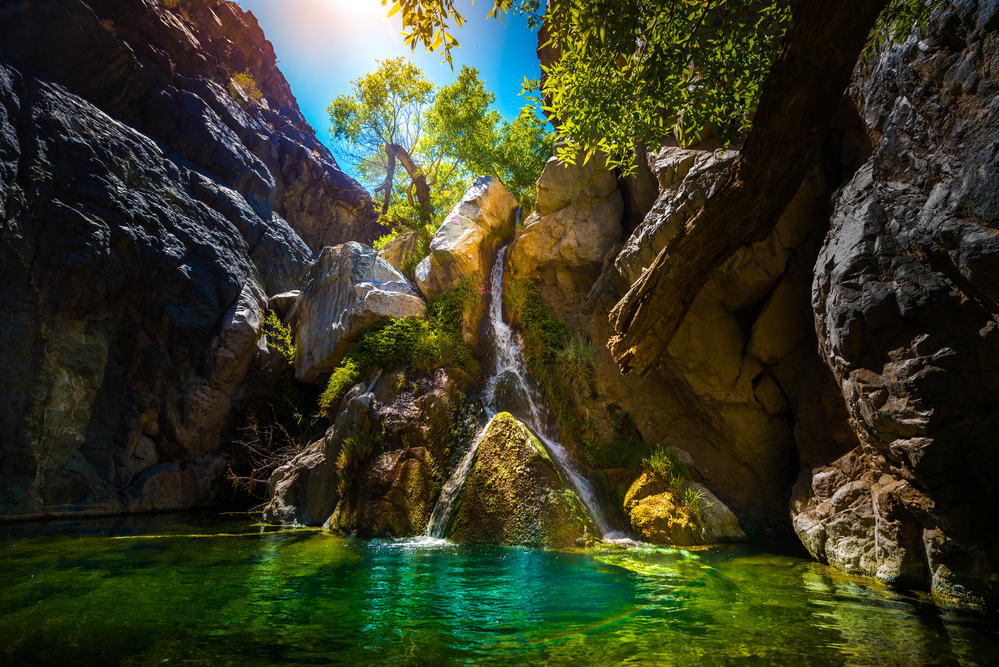
While it certainly is surprising to find bodies of water within this desert, nothing quite beats Darwin Falls. After all, a waterfall is the last thing anyone would expect to find in this US national park.
Reaching the waterfall includes an adventurous route along a dusty canyon. While it is unmarked, it is not too difficult to follow as it winds its way along the desert wash into the canyon.
The last portion of the trail takes you alongside the creek, where you will find a couple of streams. Be cautious, as the rocks here are slippery. After ducking under a few tree limbs, climbing over rocks, and making your way past several river crossings, you will reach the lush oasis and flowing waterfall.
At the waterfall, you will be able to sit and relax. Admire the beauty of this hidden gem, as well as the various bird species and dragonflies found here.

Note: It is not permissible to swim at the waterfall.
Desolation Canyon Hike
- Elevation Gain: 723 feet
- Mileage: 3.8 miles (out-and-back)
- Difficulty: Hard
- Trail Guide: Link
Desolation Canyon is one of the more secluded trails found in Death Valley National Park. On this hike, explore the eroded volcanic landscape and admire the unique colors and rock formations found throughout.
Desolation Canyon is one of the most scenic hikes; however, it is also one of the more challenging picks. This is because the trail involves a fair amount of climbing and scrambling.
The beginning of the trail features a broad gulch, which quickly narrows down. As such, you’ll need to twist into some tight passages as you make your way uphill. Around a mile in, you’ll encounter an 8-ft dry fall. This includes handholds, making it easy to climb.
While it’s easiest to simply follow the main canyon route, exploring the smaller canyons found along the way is recommended, too. After taking in views of the various geologic elements found in the canyon, continue along the main route until you’ve reached the end of the trail.
The end is a viewpoint overlooking Death Valley. From here, you’ll have incredible views over Artist’s Drive, the Black Mountains, and plenty more.
Ubehebe Crater Rim Hike
- Elevation Gain: 500 feet
- Mileage: 1.5 miles (loop)
- Difficulty: Moderate
- Trail Guide: Link
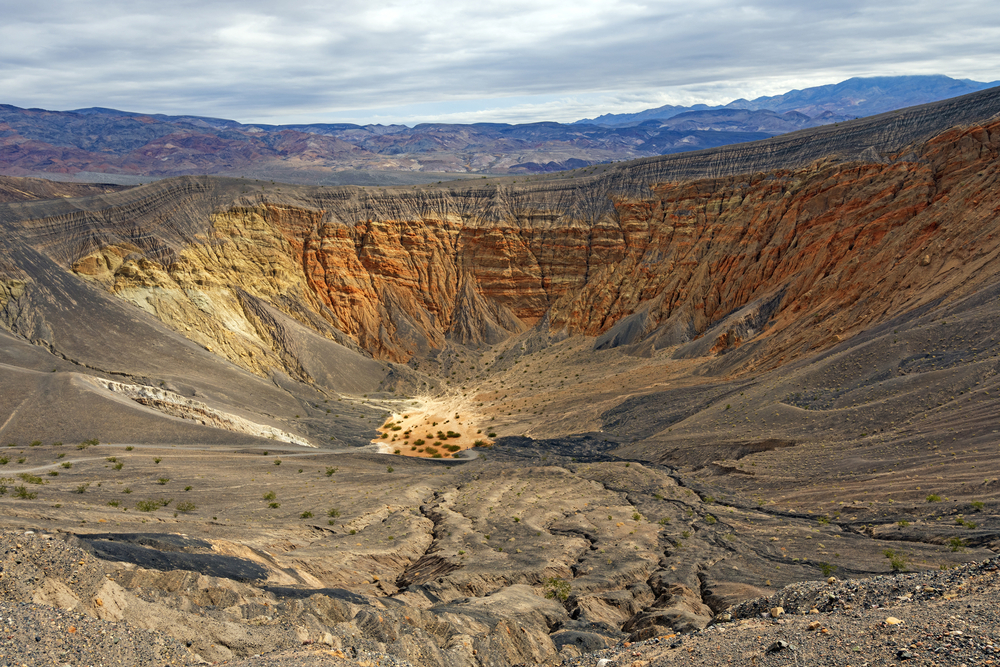
Ubehebe is one of the most incredible sights in Death Valley National Park. It is a large volcanic crater that measures 600 ft deep and 0.5 miles across.
While the crater can be viewed from the parking area, further exploration is advised. As you walk along the rim, you will feel as if you’re on Mars.
You will also be able to walk down into the crater to see the smaller craters and interesting erosion up close. This should be done with caution as the way back is incredibly steep, and the loose gravel is hard to grip.
To ensure your safety, it is best to stay on the trail. Many visitors opt to do the hike anti-clockwise as this allows you to get the climbing out of the way early on.
Ibex Dunes
- Elevation Gain: 500 feet
- Mileage: 6 miles (loop)
- Difficulty: Moderate
- Trail Guide: Link
When it comes to solitude, nothing quite beats the Ibex Dunes trail. This is largely due to the dune being hard to reach. You will need to travel with a 4WD along the roughest road in the park to access this natural wonder.
Once you’ve reached the Ibex Dunes, you’ll be met by a seemingly endless field providing some of the most breathtaking panoramic views. Take your time traversing the dunes. Many visitors opt to hike to the talc mine at the end of the trail before turning back.
Do note that navigating the dunes can be challenging. As such, it is best to bring along some sort of mapping tool to ensure you’re able to reach your destination and backtrack your steps back to your 4WD vehicle.

Tip: Do this Death Valley hike in the morning to avoid the midday heat.
How to Get to Death Valley National Park
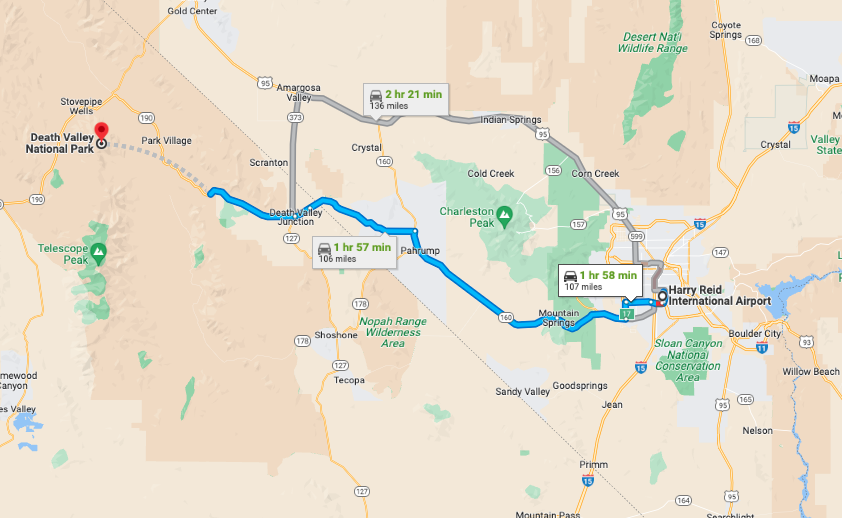
Now that you know what the best Death Valley hikes are, the next question on your mind may be how to get there.
Death Valley is located in central California near the Nevada border. The two major airports found closest to the national park are Harry Reid and Los Angeles International Airport. There is no public transportation that travels to Death Valley, so you will need to travel by car.
From Los Angeles, the drive is around 3.5 hours. This can be as long as 4.5 hours, depending on the traffic. This follows a scenic route up US Route 395 toward the park’s western entrance.
If you’re driving from Las Vegas, you’ll have a shorter journey of around 2 hours. This will take you through Death Valley Junction, a small near-ghost town commonly referred to as Amargosa (meaning “bitter” in Spanish).

Note: There are not many gas stations along the way, so be sure to start your journey with a full tank.
Best Time to Go Death Valley Hiking
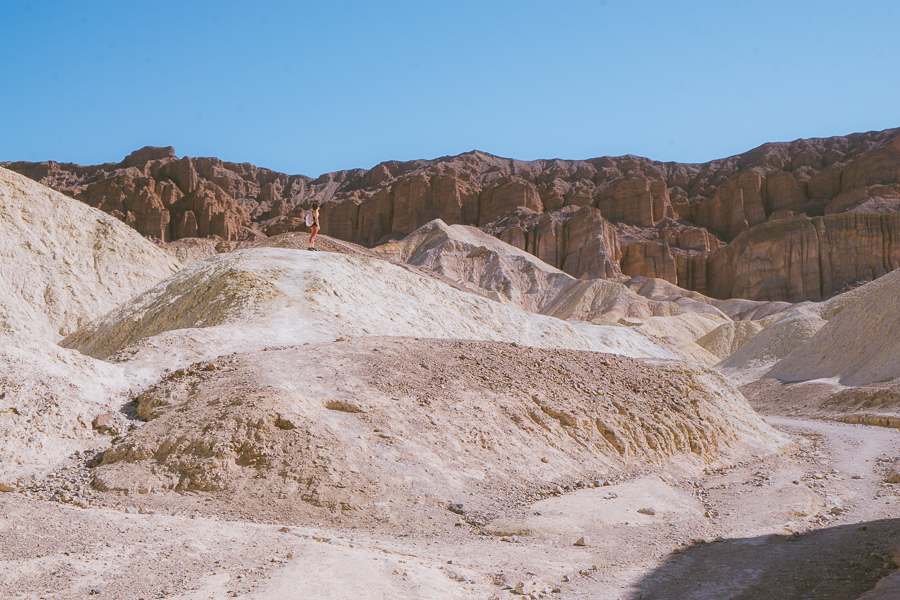
The best time to go hiking in Death Valley National Park is between November and March, which includes winter and early spring. During this time, the weather is mostly mild, with low temperatures ranging between 39ºF and 54ºF and highs between 68ºF and 77ºF. As spring approaches, this can be as high as 93ºF.
While the temperatures are high during spring, this is the most popular time to visit Death Valley. Besides providing warm and sunny days, many people flock to the national park to view the beautiful spring wildflowers. The spring break season (March to April) also brings about large crowds. So if you’re seeking greater solitude, then the winter months are best.
For the most part, it is best to avoid hiking in Death Valley during the summer months as temperatures are dangerous—particularly in the park’s lower elevations. As such, to enjoy trails like Zabriskie Point without succumbing to the park’s summer heat, staying clear of these months is best.
If you happen to find yourself here during summer, aim to hike in the early hours of the morning between sunrise and 11 am. It also helps to stick to trails that cover the park’s high peaks, as these provide a pleasant escape from the summer heat.
How Many Days Do You Need for Hiking Death Valley
Wondering how many days you need to spend in Death Valley to see all of the park’s top sights and attractions? For most, 2-3 days is best. This will provide you with enough time to explore several of the park’s top trails.
At the same time, it is absolutely possible to see Death Valley in a single day. With one full day, you will be able to see Zabriskie Point, Badwater, Furnace Creek, and Ubehebe Crater. You’ll also have time to stop by the visitor’s center and take a tour of one of the castles.
However, if you want to take your time exploring both the popular and more secluded spots by foot, a day or two extra is recommended.
Death Valley National Park Hiking: FAQs
Below are a few more frequently asked questions to ensure you’re all clued up with Death Valley hiking.
When Should You Avoid Hiking in Death Valley?
It is best to avoid hiking in Death Valley during the summer months, particularly in July. During this time, the national park is extremely hot, with lows of 90ºF and highs of up to 134ºF.
How Much Water Should You Carry in Death Valley?
Rangers recommend carrying at least one gallon of water per person, if not more. This is because dehydration and heat exhaustion are common here, given the hot and dry climate.
Do Cell Phones Work in Death Valley?
In Death Valley, cellular service is limited. As such, some people may experience slow service in some areas. There is also no WiFi in the national park other than what is provided by some of the hotels and resorts.
Does GPS Work in Death Valley?
GPS Navigation has proved to be unreliable in Death Valley National Park. As such, it is best to carry a road map with you at all times to double-check the accuracy of your GPS.
Are There Animals in Death Valley?
There are many animals in Death Valley, including mountain lions, rattlesnakes, coyotes, and bighorn sheep. To ensure your safety, read this guide on wildlife safety tips.
Experience the Best Hikes Death Valley Has to Offer
There you have it, a list of Death Valley’s best hikes. From casual hikes like Zabriskie Point to the more strenuous Grotto Canyon trail, there is an adventure for everyone. And don’t limit yourself to a single trail, as each of the trails listed offers something different.
Looking for some more incredible hiking opportunities? Head to Las Vegas and tackle some of the best Red Rock Canyon hikes.

